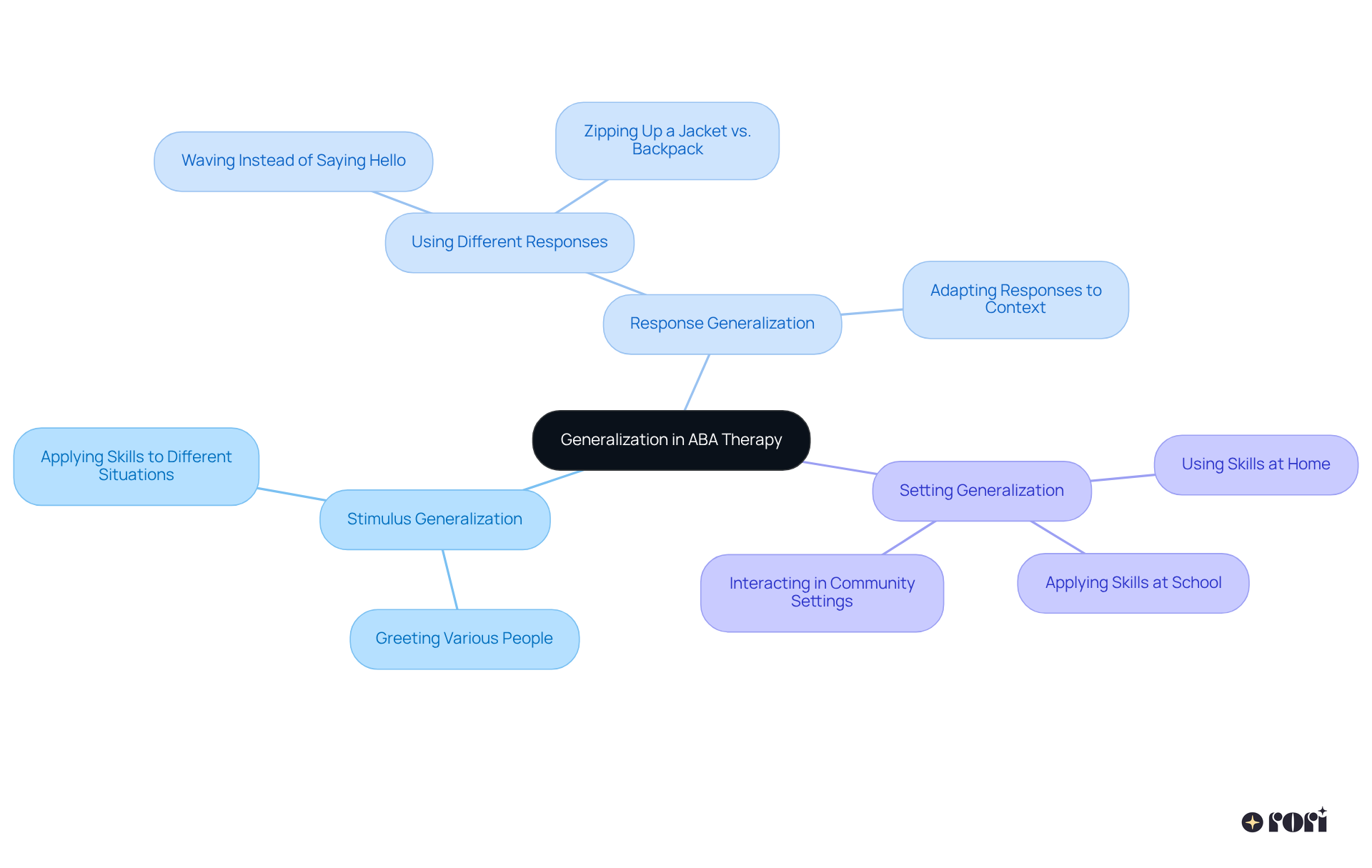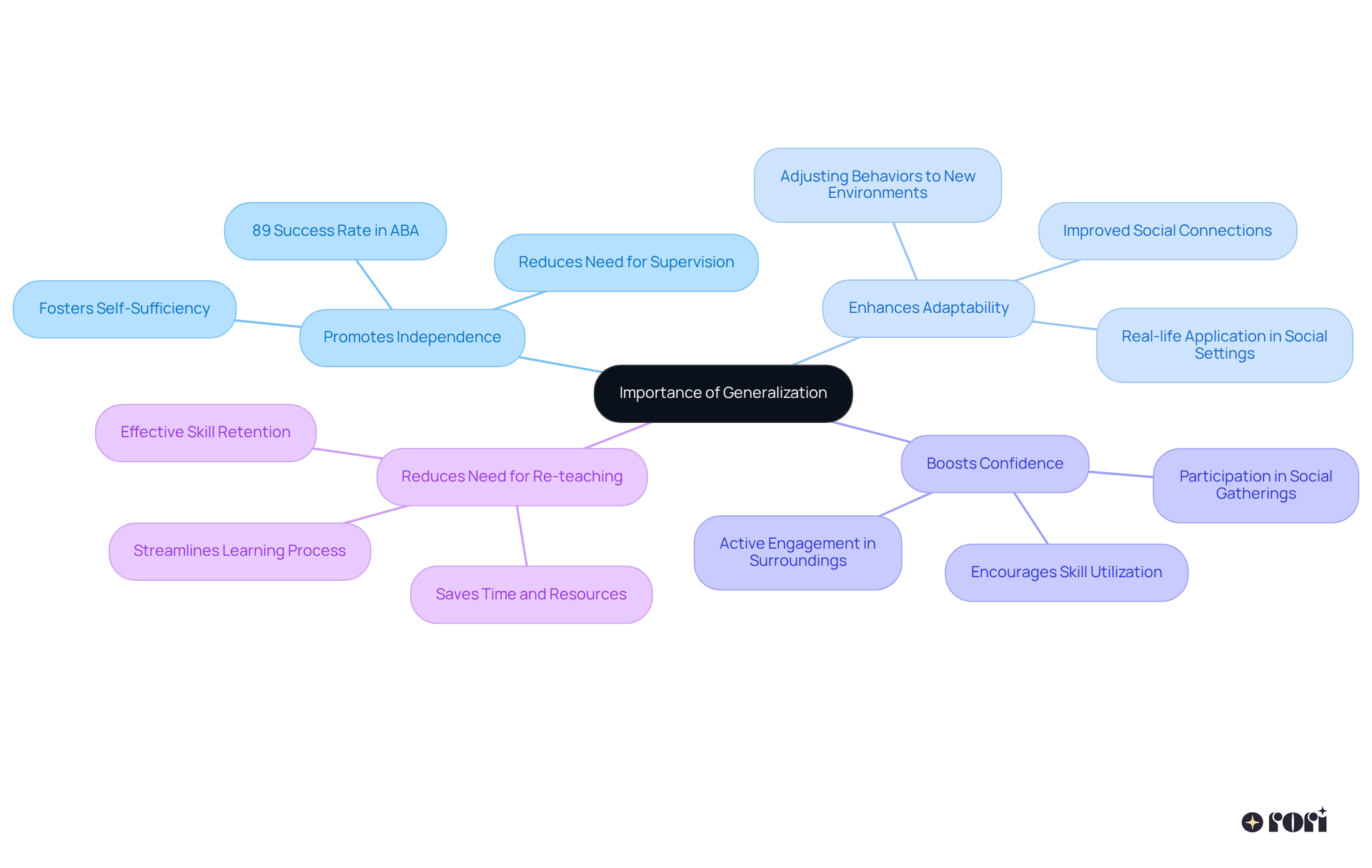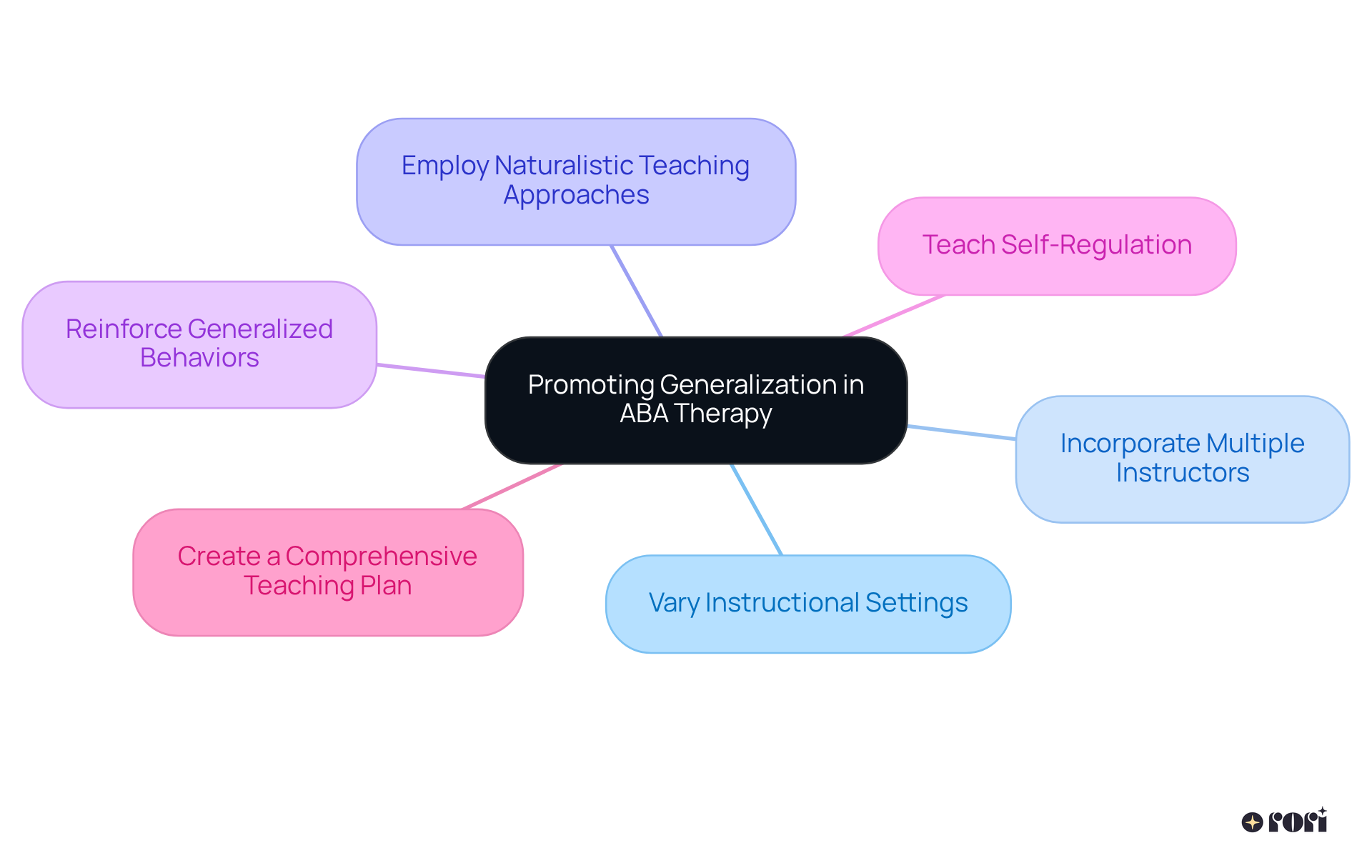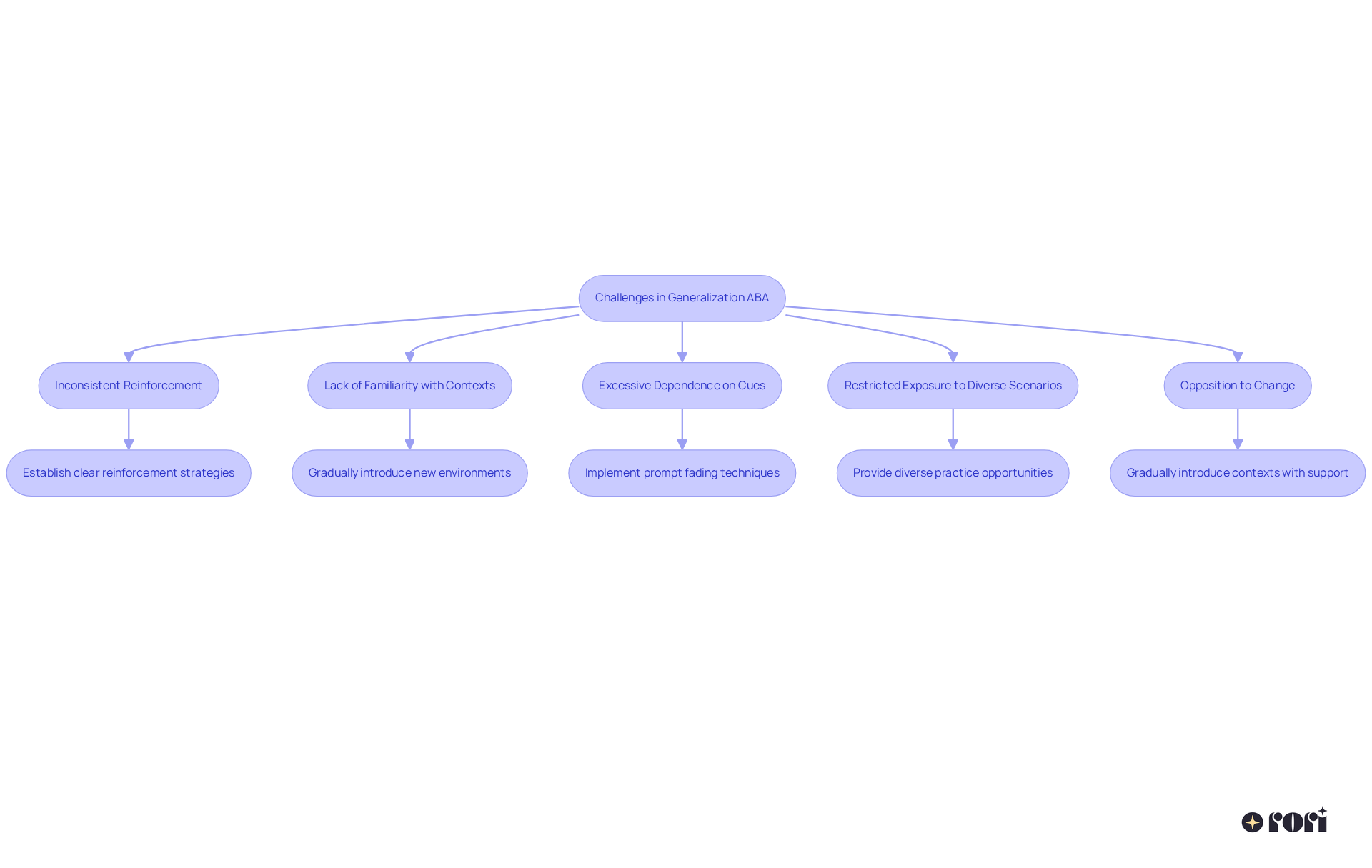This article dives into some effective strategies for skill transfer in Applied Behavior Analysis (ABA) therapy, focusing on the idea of setting generalization. You see, promoting generalization is super important for helping individuals with Autism Spectrum Disorder (ASD) apply the skills they've learned in different real-life situations. This not only boosts their independence and adaptability but also builds their confidence! Research shows a high success rate for ABA interventions, which is really encouraging.
Let’s explore this together! By understanding how to promote generalization, we can make a real difference in the lives of those we care about. After all, every little step counts toward helping them thrive in various contexts. We’re here to help you every step of the way!
Setting generalization in Applied Behavior Analysis (ABA) therapy is such an important concept, especially for kids with Autism Spectrum Disorder. It helps them apply the skills they've learned in therapy to different places and situations. In this article, we’ll explore some effective strategies that not only make it easier for these skills to transfer but also boost independence and adaptability in everyday life.
However, the road to successful generalization isn’t always smooth. Many caregivers and therapists face challenges along the way. So, how can we effectively tackle these barriers and ensure that the skills learned in therapy translate into real-world interactions? Let’s dive in and discover together!
Setting generalization ABA intervention is centered on helping young people apply the skills they've learned in one situation to different settings, people, or environments—without the need for direct instruction. For instance, when a child learns to say 'hello' during therapy sessions, generalization happens when they use that greeting at school or at home. This process is so important because it ensures that the skills gained in therapy are not just for the clinic but can be applied in everyday life, promoting independence and adaptability.
There are three types of generalization to keep in mind:
Understanding these categories can really help therapists create effective interventions that promote the transfer of skills across different contexts. Research shows that effective generalization can significantly enhance the independence and quality of life for individuals with Autism Spectrum Disorder (ASD). It’s a crucial focus in autism intervention! Kids who can generalize their skills often enjoy better social interactions and adaptive behaviors, highlighting how vital this process is for achieving meaningful outcomes in ABA therapy.
However, it’s important to remember that children with Autism Spectrum Disorder may find it challenging to be flexible in their learning, which can slow down their overall progress. Engaging caregivers and peers in training helps create a supportive environment for applying these skills, making generalization strategies even more effective.
Let’s explore this together! Your involvement can make a real difference in your child's journey toward independence.

Generalization in ABA treatment is so important for making sure that the skills learned in therapy are put to good use in everyday life. Let’s dive into why this matters:
Promotes Independence: When children can generalize their skills, they’re better equipped to handle daily life on their own. This not only reduces their need for constant supervision but also helps them become more self-sufficient. Research shows that ABA intervention boasts an impressive over 89% success rate in helping kids with autism, highlighting its role in fostering independence.
Enhances Adaptability: Being able to adjust learned behaviors to new environments is key for fitting in socially. This allows young people to connect more effectively with their peers and adults. For instance, kids who master social skills in therapy often shine during playdates or school events, showing just how much they can apply what they’ve learned.
Boosts Confidence: When kids use their skills in various situations, it really lifts their confidence! This newfound assurance encourages them to engage more actively with their surroundings and participate in social gatherings. This confidence is vital for their overall growth and social experiences.
Reduces Need for Re-teaching: When generalization is effective, it cuts down on the need for repetitive teaching in different settings. This saves precious time and resources for both therapists and families.
Real-life examples really bring these benefits to light: kids who learn social skills in therapy often show improved interactions during playdates or school events. This not only enriches their social experiences but also supports their overall development.
In conclusion, generalization is a key part of effective ABA practice. It connects structured learning with real-life application, utilizing setting generalization aba to empower kids to thrive in their daily lives. And remember, timely intervention can significantly enhance developmental outcomes, making broad application a vital focus for achieving success for individuals with autism. Let’s explore this together!

To promote generalization in ABA therapy, there are several friendly strategies you can try:
Vary Instructional Settings: Teach skills in different places like home, school, or the community. This helps young learners apply what they know in various situations.
Incorporate Multiple Instructors: Involve different therapists, parents, and caregivers in the learning process. This exposure helps kids learn to generalize their skills across various people by setting generalization aba.
Employ Naturalistic Teaching Approaches: Use methods like incidental instruction and role-playing to create real-life situations where kids can practice their skills. For example, practicing communication skills during playtime can really boost their social interactions.
Reinforce Generalized Behaviors: Offer positive reinforcement when kids use their skills in different contexts. This encouragement motivates them to keep using those skills outside of therapy.
Teach Self-Regulation: Help young people recognize when they need to use a skill and how to do it independently. You can use checklists or visual cues to support them.
Create a Comprehensive Teaching Plan: Develop a clear plan that outlines specific strategies for helping skills transfer, ensuring all caregivers are on the same page.
By using these friendly tactics, therapists and families can greatly improve the chances of successful skill transfer, which is crucial for setting generalization aba, leading to even better outcomes for our youth. Let’s explore this together!

Setting generalization aba is crucial, but it can present its own set of challenges. Let’s take a closer look at some common obstacles and how we can tackle them together!
Inconsistent Reinforcement: When caregivers don’t consistently reinforce generalized behaviors, kids might not use their learned skills outside of treatment. To fix this, it’s helpful to establish clear reinforcement strategies within the setting generalization aba that everyone can follow. Research shows that positive reinforcement is key in ABA therapy, making a big difference in learning and compliance.
Lack of Familiarity with Contexts: Kids might have a hard time generalizing skills if they’re not familiar with a new environment. Gradually introducing them to different areas as part of the setting generalization aba and practicing skills in those settings can make a big difference. Did you know that about 1 in 36 youths in the U.S. is recognized with autism? This highlights the need for effective strategies in setting generalization aba across various environments.
Excessive Dependence on Cues: If children rely too much on cues during therapy, they might not learn to use their skills independently. Try implementing prompt fading techniques to encourage them to use their abilities on their own. Studies show that kids who undergo intensive ABA therapy often make significant progress, with many reaching levels similar to their peers.
Restricted Exposure to Diverse Scenarios: When kids only practice their skills in a limited range of contexts, generalization can become tricky. It’s essential to provide diverse practice opportunities that involve setting generalization aba across various scenarios. This approach aligns with evidence-based practices that focus on personalized assessments and data-driven decisions.
Opposition to Change: Some kids might feel anxious or uncomfortable applying their skills in new situations. Gradually introducing them to these contexts and offering support by using setting generalization aba can help ease their worries. Building trust is vital in ABA therapy, as it fosters a positive attitude toward applying their skills.
By recognizing these challenges and using targeted strategies, families and therapists can boost the effectiveness of generalization efforts. Together, we can help children successfully apply their skills in real-world situations. Let’s explore this journey together!

Generalization in ABA therapy is so important for helping skills learned in structured environments translate into everyday life. By focusing on this process, individuals with Autism Spectrum Disorder can gain greater independence and adaptability, which leads to a better quality of life. When children can apply what they've learned in different settings, it not only boosts their self-sufficiency but also enhances social interactions. This makes generalization a key part of successful ABA interventions.
Throughout this article, we’ve explored some key strategies for promoting generalization. These include:
These methods create a supportive environment where children can practice and reinforce their skills in various contexts. Plus, addressing common challenges like inconsistent reinforcement and reliance on cues is essential for overcoming obstacles to effective generalization.
Ultimately, we can’t underestimate the importance of generalization in ABA therapy. It acts as a bridge between learning and real-world application, empowering children to thrive in their daily lives. By actively engaging in this process and implementing effective strategies, caregivers and therapists can play a vital role in facilitating skill transfer. This ensures that the benefits of ABA extend beyond the therapy room, leading to meaningful social interactions and independent living.
So, let’s explore this together! Remember, you’re not alone in this journey. We’re here to help you every step of the way!
What is the definition of generalization in ABA therapy?
Generalization in ABA therapy refers to helping individuals apply the skills they've learned in one situation to different settings, people, or environments without direct instruction.
Why is generalization important in ABA therapy?
Generalization is important because it ensures that the skills gained in therapy can be applied in everyday life, promoting independence and adaptability for individuals, particularly those with Autism Spectrum Disorder (ASD).
What are the three types of generalization in ABA therapy?
The three types of generalization are: - Stimulus Generalization: Applying learned behavior to different stimuli, like greeting various people. - Response Generalization: Using different responses for the same situation, such as waving instead of saying hello. - Setting Generalization: Using learned behaviors in different settings, like at home, school, or in the community.
How does generalization impact individuals with Autism Spectrum Disorder?
Effective generalization can significantly enhance independence and quality of life for individuals with ASD, leading to better social interactions and adaptive behaviors.
What challenges do children with Autism Spectrum Disorder face regarding generalization?
Children with ASD may find it challenging to be flexible in their learning, which can slow down their overall progress in applying learned skills.
How can caregivers and peers support the generalization process?
Engaging caregivers and peers in training helps create a supportive environment for applying skills, making generalization strategies more effective.